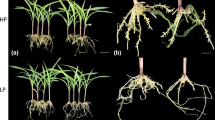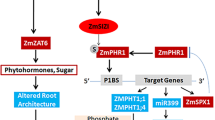Abstract
A bHLH (basic helix-loop-helix domain) transcription factor involved in tolerance to Pi starvation was cloned from Zea mays with an RT-PCR coupled RACE approach and named ZmPTF1. ZmPTF1 encoded a putative protein of 481 amino acids that had identity with OsPTF1 in basic region. Real-time RT-PCR revealed that ZmPTF1 was quickly and significantly up-regulated in the root under phosphate starvation conditions. Overexpression of ZmPTF1 in maize improved root development, enhanced biomass both in hydroponic cultures and sand pots, and the plants developed more tassel branches and larger kernels when they were grown in low phosphate soil. Compared with wild type, overexpressing ZmPTF1 altered the concentrations of soluble sugars in transgenic plants, in which soluble sugars levels were lower in the leaves and higher in the roots. Overexpression of ZmPTF1 enhanced the expression of fructose-1,6-bisphosphatase and sucrose phosphate synthase1 participated in sucrose synthesis in the leaves but decreased them in the root, and reduced the expression of genes involved in sucrose catabolism in the roots. The modifications on the physiology and root morphology of the plants enhanced low phosphate tolerance and increased the yield under low phosphate conditions. This research provides a useful gene for transgenic breeding of maize that is tolerant to phosphate deficiency and is helpful for exploring the relationship between sugar signaling and phosphate concentrations in cells.






Similar content being viewed by others
Abbreviations
- RACE:
-
Rapid-amplification of cDNA ends
- bHLH:
-
Basic helix-loop-helix domain
- ORF:
-
Open reading frame
- SP:
-
Sufficient phosphate nutrient solution
- LP:
-
Low phosphate nutrient solution
- Pi:
-
Phosphate
- Als :
-
Acetolactate synthase gene
References
Bari R, Pant BD, Stitt M, Scheible WR (2006) Pho2, microRNA399, and PHR1 define a phosphate-signaling pathway in plants. Plant Physiol 141:988–999
Brini F, Hanin M, Mezghani I, Berkowitz GA, Masmoudi K (2007) Overexpression of wheat Na+/H+ antiporter TNHX1 and H+- pyrophosphatase TVP1 improves salt- and drought-stress tolerance in Arabidopsis thaliana plants. J Exp Bot 58:301–308
Calderon-Vazquez C, Ibarra-Laclette E, Caballero-Perez J, Herrera-Estrella L (2008) Transcript profiling of Zea mays roots reveals gene responses to phosphate deficiency at the plant- and species-specific levels. J Exp Bot 59:2479–2497
Chiou TJ, Aung K, Lin SI, Wu CC, Chiang SF, Su CL (2006) Regulation of phosphate homeostasis by microRNA in Arabidopsis. Plant Cell 18:412–421
Cornejo MJ, Luth D, Blankenship KM, Anderson OD, Blechl AE (1993) Activity of a maize ubiquitin promoter in transgenic rice. Plant Mol Biol 23:567–581
Devaiah BN, Karthikeyan AS, Raghothama KG (2007) WRKY75 transcription factor is a modulator of phosphate acquisition and root development in Arabidopsis. Plant Physiol 143:1789–1801
Franco-Zorrilla JM, Martın AC, Leyva A, Paz-Ares J (2005) Interaction between phosphate-starvation, sugar, and cytokinin signaling in Arabidopsis and the roles of cytokinin receptors CRE1/AHK4 and AHK3. Plant Physiol 138:847–857
González E, Solano R, Rubio V, Leyva A, Paz-Ares J (2005) Phosphate transporter traffic facilitator 1 is a plant-specific SEC12-related protein that enables the endoplasmic reticulum exit of a high-affinity phosphate transporter in Arabidopsis. Plant Cell 17:3500–3512
Hammond JP, Bennett MJ, Bowen HC, Broadley MR, Eastwood DC, May ST, Ralm C, Swarup R, Woolaway KE, White PJ (2003) Changes in genes expression in Arabidopsis shoots during phosphate starvation and the potential for developing smart plants. Plant Physiol 132:1–19
Hammond JP, Broadley MR, White PJ (2004) Genetic responses to phosphorus deficiency. Ann Bot 94:323–332
Hermans C, Hammond JP, White PJ, Verbruggen N (2006) How do plants respond to nutrient shortage by biomass allocation? Trends Plant Sci 11:610–617
Hernández G, Ramírez M, Valdés-López O et al (2007) Phosphorus stress in common bean: root transcript and metabolic responses. Plant Physiol 144:752–767
Jain A, Poling MD, Karthikeyan AS, Blakeslee JJ, Peer WA, Titapiwatanakun B, Murphy AS, Raghothama KG (2007) Differential effects of sucrose and auxin on localized phosphate deficiency-induced modulation of different traits of root system architecture in Arabidopsis. Plant Physiol 144:232–247
Karthikeyan AS, Varadarajan DK, Jain A, Held MA, Carpita NC, Raghothama KG (2007) Phosphate starvation responses are mediated by sugar signaling in Arabidopsis. Planta 225:907–918
Koch KE (1996) Carbohydrate-modulated gene expression in plants. Annu Rev Plant Physiol Plant Mol Biol 47:509–540
Li K, Xu Z, Zhang K, Yang A, Zhang J (2007a) Efficient production and characterization for maize inbred lines with low-phosphorus tolerance. Plant Sci 172:255–264
Li K, Xu C, Zhang K, Yang A, Zhang J (2007b) Proteomic analysis of roots growth and metabolic changes under phosphorus deficit in maize (Zea mays L.) plants. Proteomics 7:1501–1512
Li B, Wei A, Song C, Li N, Zhang J (2008) Heterologous expression of the TsVP gene improves the drought resistance of maize. Plant Biotechnol 6:146–159
Lin SI, Chiang SF, Lin WY, Chen JW, Tseng CY, Wu PC, Chiou TJ (2008) Regulatory network of microRNA399 and PHO2 by systemic signaling. Plant Physiol 147:732–746
Liu J, Samac DA, Bucciarelli B, Allan DL, Vance CP (2005) Signaling of phosphorus deficiency-induced gene expression in white lupin requires sugar and phloem transport. Plant J 41:257–268
Livak KJ, Schmittgen TW (2001) Analysis of relative gene expression data using real-time quantitative PCR and the 2-ΔΔCt method. Methods 25:402–408
Lu C, Lim E, Yu S (1998) Sugar response sequence in the promoter of a rice α-amylase gene serves as a transcriptional enhancer. J Chemom 273:10120–10131
Mishra B, Singh M, Aggrawal P, Laxmi A (2009) Glucose and auxin signaling interaction in controlling Arabidopsis thaliana seedlings root growth and development. PLoS ONE 4:e4502
Misson J, Raghothama KG, Jain A et al (2005) A genome-wide transcriptional analysis using Arabidopsis thaliana Affymetrix gene chips. Proc Natl Acad Sci USA 102:11934–11939
Miura K, Rus A, Sharkhuu A et al (2005) The Arabidopsis SUMO E3 ligase SIZ1 controls phosphate deficiency responses. Proc Natl Acad Sci USA 102:7760–7765
Mollier A, Pellerin S (1999) Maize root system growth and development as influenced by phosphorus deficiency. J Exp Biol 50:487–497
Murphy J, Riley JP (1962) A modified single solution method for the determination of phosphate in natural waters. Anal Chimica Acta 27:31–37
Musick GJ, Fairchild ML, Ferguson VL, Zuber MS (1965) A method of measuring root volume in corn (Zea mays L.). Crop Sci 5:601–602
Pant B, Buhtz A, Kehr J, Scheible W (2008) MicroRNA399 is a long-distance signal for the regulation of plant phosphate homeostasis. Plant J 53:731–738
Park S, Li J, Pittman JK, Berkowitz GA, Yang H, Undurraga S, Morris J, Hirschi KD, Gaxiola RA (2005) Up-regulation of an H+-pyrophosphatase n(H+-PPase) as a strategy to engineer drought-resistant crop plants. Proc Natl Acad Sci USA 102:18830–18835
Rubio V, Linhares F, Solano R, Martin AC, Iglesias J, Leyva A, Paz-Ares J (2001) A conserved MYB transcription factor involved in phosphate starvation signalling both in vascular plants and in unicellular algae. Genes Dev 15:2122–2133
Sambrook J, Fritsch EF, Maniatis T (2000) Molecular cloning: A laboratory manual, 3rd edn. Cold Spring Harbor Laboratory Press, Cold Spring Harbor
Shi H, Lee B, Wu SJ, Zhu JK (2003) Overexpression of a plasma membrane Na+/H+ antiporter gene improves salt tolerance in Arabidopsis. Nat Biotechnol 21:81–85
Tamura K, Dudley J, Nei M, Kumar S (2007) MEGA4: Molecular Evolutionary Genetics Analysis (MEGA) software version 4.0. Mol Bio Evol 24:1596–1599
Vance CP (2010) Quantitative trait loci, epigenetics, sugars, and microRNAs: quaternaries in phosphate acquisition and use. Plant Physiol 154:582–588
Wasaki J, Yonetani R, Kuroda S, Shinano T, Yazaki J, Fujii F, Shimbo K, Yamamoto K, Sakata K, Sasaki T (2003) Transcriptomic analysis of metabolic changes by phosphorus stress in rice plant roots. Plant Cell Environ 26:1515–1523
Wasaki J, Shinano T, Onishi K, Yonetani R, Yazaki J, Fujii F, Shimbo K, Ishikawa M, Shimatani Z, Nagata Y, Hashimoto A, Ohta T, Sato Y, Miyamoto C, Honda S, Kojima K, Sasaki T, Kishimoto N, Kikuchi S, Osaki M (2006) Transcriptomic analysis indicates putative metabolic changes caused by manipulation of phosphorus availability in rice leaves. J Exp Bot 57:2049–2059
Wu P, Ma LG, Hou XL, Wang MY, Wu YR, Liu FY, Deng X (2003) Phosphate starvation triggers distinct alterations of genome expression in Arabidopsis roots and leaves. Plant Physiol 132:1260–1271
Yemm EW, Willis AJ (1954) The estimation of carbohydrates in plant extracts by the anthrone. Biochem J 57:508–514
Yi K, Wu Z, Zhou J, Du L, Guo L, Wu Y, Wu P (2005) OsPTF1, a novel transcription factor involved in tolerance to phosphate starvation in rice. Plant Physiol 138:2087–2096
Acknowledgments
We thank Dr. Roberta Greenwood (Shandong University, Shandong, China) for her critical reading of the manuscript. This research was supported by National Basic Research Program of China (973 Program,2009CB118400) and Natural Science Foundation of China (No. 30771127).
Author information
Authors and Affiliations
Corresponding author
Additional information
An erratum to this article can be found at http://dx.doi.org/10.1007/s00425-011-1404-1
Electronic supplementary material
Below is the link to the electronic supplementary material.
Rights and permissions
About this article
Cite this article
Li, Z., Gao, Q., Liu, Y. et al. Overexpression of transcription factor ZmPTF1 improves low phosphate tolerance of maize by regulating carbon metabolism and root growth. Planta 233, 1129–1143 (2011). https://doi.org/10.1007/s00425-011-1368-1
Received:
Accepted:
Published:
Issue Date:
DOI: https://doi.org/10.1007/s00425-011-1368-1




